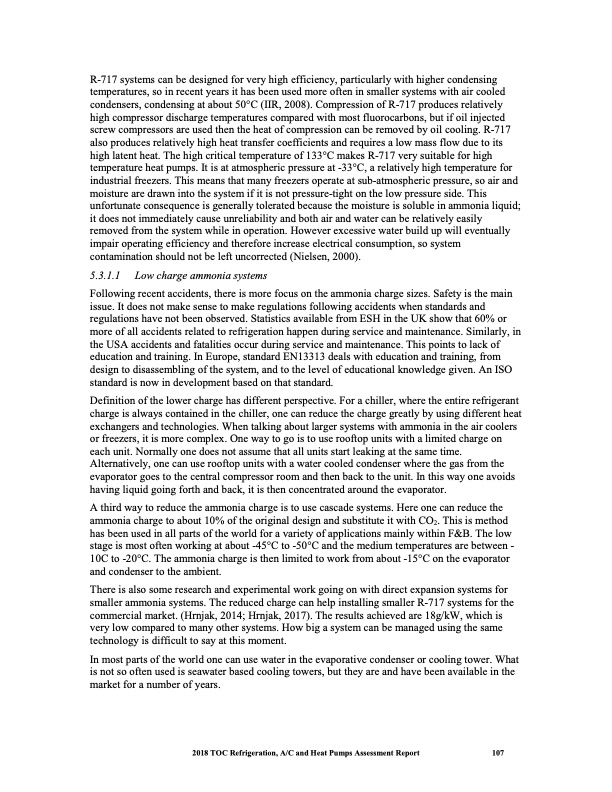
PDF Publication Title:
Text from PDF Page: 120
R-717 systems can be designed for very high efficiency, particularly with higher condensing temperatures, so in recent years it has been used more often in smaller systems with air cooled condensers, condensing at about 50°C (IIR, 2008). Compression of R-717 produces relatively high compressor discharge temperatures compared with most fluorocarbons, but if oil injected screw compressors are used then the heat of compression can be removed by oil cooling. R-717 also produces relatively high heat transfer coefficients and requires a low mass flow due to its high latent heat. The high critical temperature of 133°C makes R-717 very suitable for high temperature heat pumps. It is at atmospheric pressure at -33°C, a relatively high temperature for industrial freezers. This means that many freezers operate at sub-atmospheric pressure, so air and moisture are drawn into the system if it is not pressure-tight on the low pressure side. This unfortunate consequence is generally tolerated because the moisture is soluble in ammonia liquid; it does not immediately cause unreliability and both air and water can be relatively easily removed from the system while in operation. However excessive water build up will eventually impair operating efficiency and therefore increase electrical consumption, so system contamination should not be left uncorrected (Nielsen, 2000). 5.3.1.1 Low charge ammonia systems Following recent accidents, there is more focus on the ammonia charge sizes. Safety is the main issue. It does not make sense to make regulations following accidents when standards and regulations have not been observed. Statistics available from ESH in the UK show that 60% or more of all accidents related to refrigeration happen during service and maintenance. Similarly, in the USA accidents and fatalities occur during service and maintenance. This points to lack of education and training. In Europe, standard EN13313 deals with education and training, from design to disassembling of the system, and to the level of educational knowledge given. An ISO standard is now in development based on that standard. Definition of the lower charge has different perspective. For a chiller, where the entire refrigerant charge is always contained in the chiller, one can reduce the charge greatly by using different heat exchangers and technologies. When talking about larger systems with ammonia in the air coolers or freezers, it is more complex. One way to go is to use rooftop units with a limited charge on each unit. Normally one does not assume that all units start leaking at the same time. Alternatively, one can use rooftop units with a water cooled condenser where the gas from the evaporator goes to the central compressor room and then back to the unit. In this way one avoids having liquid going forth and back, it is then concentrated around the evaporator. A third way to reduce the ammonia charge is to use cascade systems. Here one can reduce the ammonia charge to about 10% of the original design and substitute it with CO2. This is method has been used in all parts of the world for a variety of applications mainly within F&B. The low stage is most often working at about -45°C to -50°C and the medium temperatures are between - 10C to -20°C. The ammonia charge is then limited to work from about -15°C on the evaporator and condenser to the ambient. There is also some research and experimental work going on with direct expansion systems for smaller ammonia systems. The reduced charge can help installing smaller R-717 systems for the commercial market. (Hrnjak, 2014; Hrnjak, 2017). The results achieved are 18g/kW, which is very low compared to many other systems. How big a system can be managed using the same technology is difficult to say at this moment. In most parts of the world one can use water in the evaporative condenser or cooling tower. What is not so often used is seawater based cooling towers, but they are and have been available in the market for a number of years. 2018 TOC Refrigeration, A/C and Heat Pumps Assessment Report 107PDF Image | Heat Pumps Technical Options

PDF Search Title:
Heat Pumps Technical OptionsOriginal File Name Searched:
RTOC-assessment-report-2018_0.pdfDIY PDF Search: Google It | Yahoo | Bing
CO2 Organic Rankine Cycle Experimenter Platform The supercritical CO2 phase change system is both a heat pump and organic rankine cycle which can be used for those purposes and as a supercritical extractor for advanced subcritical and supercritical extraction technology. Uses include producing nanoparticles, precious metal CO2 extraction, lithium battery recycling, and other applications... More Info
Heat Pumps CO2 ORC Heat Pump System Platform More Info
| CONTACT TEL: 608-238-6001 Email: greg@infinityturbine.com | RSS | AMP |